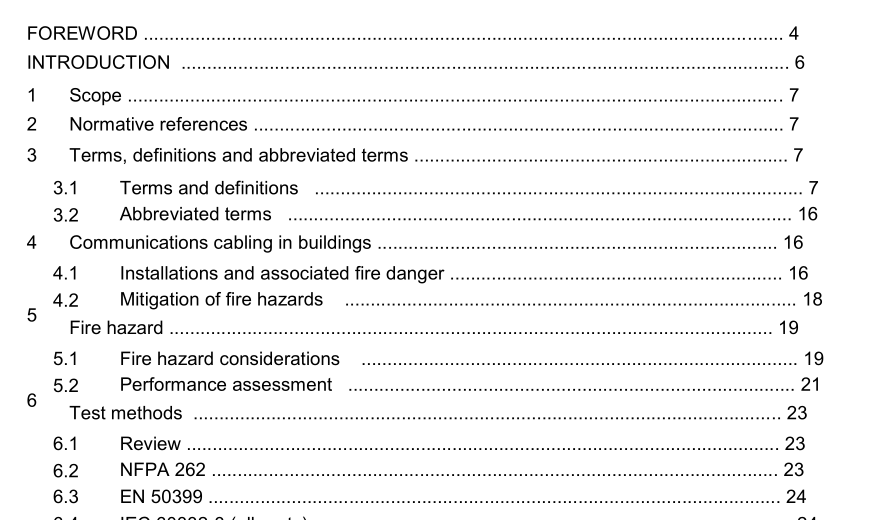IEC TR 62222-2021 pdf Fire performance of communication cables installed in buildings

More recently, standards for remote powering over generic information technology cabling have resulted in a further increase in installations to support distributed building services in all types of premises. Whilst cables may be installed in conformance with a required transmission performance, they are unlikely to perform in the same manner under fire conditions. The reaction to fire tests do not normally assess transmission performance. The pass/fail criteria for resistance to fire tests are typically a simple degradation in cable transmission performance, which might not ensure that the system itself continues to perform at the required level. The generic structured cabling system is a hierarchical star network linking distributors to other distributors and to outlets distributed throughout the premises. Cables are routed in risers between floors and in ceiling and underfloor voids. Even in a small office, this leads to a large number of cables being run in building voids. Generic cabling systems use copper conductor cables manufactured to IEC 61156 (all parts) (EN 50288 series in Europe) and optical cables manufactured to IEC 60794-2 (all parts). These standards detail electrical and optical transmission requirements, mechanical performance and environmental characteristics. Communication cables operating at low voltages and currents are not a primary cause of fires, but their widespread use means that they may be involved in outbreaks of fire from an external source. In order to define the appropriate fire test methods and performance requirements, it is necessary to consider the fire hazards presented by typical cable installations. IEC 60695-1-10 gives general guidance on the fire hazards of electrotechnical products.
A review of typical installations of communication cables in buildings, summarised in Annex A, suggests the following general trends. a) In public buildings such as airports, shops and older commercial offices with solid floors, cables are generally installed in ceiling voids with some local cabling in wall ducts. Standards specify segregation of communication and power cables in relation to electromagnetic interference and local regulations generally require segregation for electrical safety. b) Generally, in offices and newer commercial offices, cables are installed in ceiling/underfloor voids and wall ducts. Lighting power cables and some communication cables are run in ceiling voids, whilst computer and telephone cables and their associated low voltage power cables are often run in underfloor voids. Again, standards specify segregation of communication and power cables in relation to electromagnetic interference and local regulations generally require segregation for electrical safety. In such installations, relatively shallow raised flooring provides the underfloor voids.
- ISO IEC 27050-4-2021 pdf Information technology — Electronic discovery — Part 4: Technical readiness
- ISO IEC 27036-1-2021 pdf Cybersecurity — Supplier relationships — Part 1: Overview and concepts
- ISO IEC 27013-2021 pdf Information security, cybersecurity and privacy protection — Guidance on the integrated implementation of ISO/IEC 27001 and ISO/IEC 20000-1
- ISO IEC 26580-2021 pdf Software and systems engineering — Methods and tools for the feature- based approach to software and systems product line engineering
- ISO IEC 24735-2021 pdf Information technology — Office equipment — Method for measuring digital copying productivity
- ISO IEC 24711-2021 pdf Information technology — Office equipment — Method for the determination of ink cartridge yield for colour inkjet printers and multi- function devices that contain printer components
- ISO IEC 23544-2021 pdf Information Technology — Data centres — Application Platform Energy Effectiveness (APEE)
- ISO IEC 23510-2021 pdf Information technology — 3D printing and scanning — Framework for an Additive Manufacturing Service Platform (AMSP)
- ISO IEC 23127-1-2021 pdf Information technology — Learning, education, and training — Metadata for facilitators of online learning — Part 1: Framework
- ISO IEC 23126-2021 pdf Information technology for learning, education and training — Ubiquitous learning resource organization and description framework
- IEC 62576-2009 pdf Electric double-layer capacitors for use in hybrid electric vehicles – Test methods for electrical characteristics
- IEC 62488-3-2021 pdf Power line communication systems for power utility applications – Part 3: Digital Power Line Carrier (DPLC) Terminals and hybrid ADPLC Terminals
- IEC TR 62713-2013 pdf Safety procedures for reduction of risk outside a structure
- IEC 60317-31-2015 pdf Specifications for particular types of winding wires – Part 31: Glass fibre wound, resin or varnish impregnated, bare or enamelled rectangular copper wire, temperature index 180
- AS IEC 60601.2.22-2014 pdf Medical electrical equipment Part 2.22: Particular requirements for basic safety and essential performance of surgical, cosmetic, therapeutic and diagnostic laser equipment
- BS ISO IEC 15420-2009 pdf Information technology一 Automatic identification and data capture techniques EAN/UPC bar code symbology specification
- BS IEC 60860-2014 pdf Radiation protection instrumentation一 Warning equipment for criticality accidents
- BS ISO IEC 19762.5-2008 pdf Information technology一 Automatic identification and data capture (AIDC) techniques – Harmonized vocabulary Part 5: Locating systems
- ISO IEC 24735-2021 pdf Information technology — Office equipment — Method for measuring digital copying productivity
- ISO IEC 24711-2021 pdf Information technology — Office equipment — Method for the determination of ink cartridge yield for colour inkjet printers and multi- function devices that contain printer components